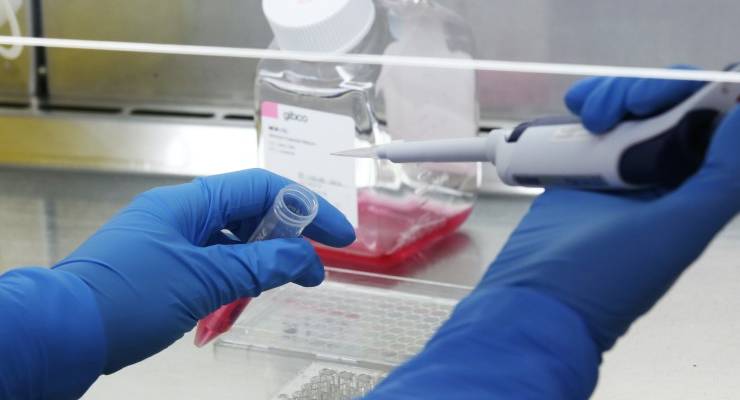
Widespread coronavirus testing in Germany has been lauded for the country’s low fatality rate, with experts stressing the importance of testing widely early.
Germany has more than 10,000 cases, with experts saying the number of undetected cases is low. Its fatality rate of 0.5% is currently the lowest in the world.
Australia is testing 10,000 people a day with newly-loosened guidelines for who can be tested amid a rise in community transmissions.
Crikey takes a look at what other measures Australia is taking in testing — and asks if we’re doing enough.
Who can get tested?
Government guidelines have expanded to allow people who have not travelled overseas or been in contact with a confirmed case to be tested.
Testing has been approved for people who have been hospitalised with a fever and acute respiratory symptoms; and people with either fever or acute respiratory symptoms who work in high-risk settings.
These settings include aged care, healthcare or residential care, rural and remote communities, detention or military centres, or regions with an elevated risk of community transmissions.
It also includes people who have been in close contact with confirmed cases within 14 days, or who have travelled internationally or have been on a cruise ship.
Associate professor Adam Kamradt-Scott, a leading infectious disease expert at the Centre for International Security Studies at the University of Sydney, told Crikey the new criteria was timely.
“The focus can now be on community testing as we now have community transmissions,” he said.
Australia currently has a similar fatality rate to Germany, says Kamradt-Scott — though with a smaller sample size.
“We’re able to identify people who are positive. In the event they develop serious illness, we can rapidly get them healthcare to reduce the severity,” he said.
Kamradt-Scott believes, given the scarce resources, Australia’s testing has been conducted as well and widely as possible.
Fifteen-minute test to arrive early next week
Half a million coronavirus tests, which require just a single drop of blood and provide results in 15 minutes, are set to be rolled out in Australia from early next week.
The test has been developed by Australian-based company Endo X and manufactured in Hong Kong, where 100,000 tests can be produced in a day. The tests were approved by the Therapeutic Goods Administration on March 20.
Endo X director Dr David Badov told Crikey the tests were fast and simple. “You don’t need to take blood or swabs and send it to a pathology lab or hospital, which causes delays,” he said.
They cost around $22 each, and check for two different kinds of antibodies present when someone is infected with coronavirus, or if they’ve been protected and developed immunity. Badov was unable to confirm whether the Australian government had purchased all 500,000 kits.
Millions of the kits have already been made available to the general public in the UK, marketed as home-testing kits and delivered by Amazon — though this is unlikely to happen in Australia, Badov told Crikey.
“It can sometimes be difficult to interpret tests, so it’s best to be done by a healthcare professional,” he said. The company doesn’t sell to individuals in Australia, but have had enquiries from large mining companies with nursing staff available to test employees.
“In other countries, people in critical professions like nurses, doctors and people who work in aged care have been doing the finger prick tests daily,” he said.
The test has a detection accuracy rate of 99.3% when used between 11 to 24 days of developing symptoms — though this drops to 94.6% when used from four to 10 days, meaning it can miss positive cases early in the course of the disease, when a patient’s immune system has not yet created antibodies.
Kamradt-Scott stressed the importance of testing all new products, adding immunity rates would provide useful data. For now, “the focus has to be testing, isolating and contact tracing”.
The current state of testing
Australia was the second country behind China to successfully develop a lab-grown version of the disease and develop a test.
Professor Sharon Lewin, a leading infectious diseases expert at the Doherty Institute, which created the test, told Crikey Australia they had tests up and running by January 24.
“The test we use looks for genetic material for the virus. It’s the same method we use to track HIV,” Lewin said. It requires a nose or throat swab to be taken and sent to a laboratory, where a test takes around six hours. Patients usually receive results between 48 and 72 hours from being swabbed.
A spokesperson for the Doherty Institute was not able to confirm the test’s accuracy rate or cost, but both are believed to be higher than the antibody test. It cannot detect if someone has developed an immunity to the disease.
The federal government has also provided $2.6 million funding for the Doherty Institute to develop a blood test which would deliver results in 30 minutes, while a 45-minute gene test has also been approved for use in Australia by the TGA.
Crikey understands doctors are provided tests and do not get to choose the type used.
Two drive-through testing clinics have been set up in South Australia, and another opened in the ACT.








Thank goodness for the expanded criteria for testing. I was befuddled by the circular logic from Scottie from Marketing that every case we have detected was either from overseas or had contact with someone from overseas when THAT WAS THE CRITERIA FOR BEING TESTED!
Times 1000
We need to be careful to distinguish between the two types of test currently being referenced.
The simple quick one is a test for the antibodies relating to COVID19, they demonstrate that the person has been in contact with or recovered from the virus. As I understand it these quick versions test for two antibodies using a version of ‘litmus’ paper to collect the drop of blood, a solution to run the blood onto the active chemistry that then gives the result. In short a sophisticated pregnancy test. The Czecks bought half a million of these and found out the difference the hard way.
The second slower test that requires lab work is the important one for detecting live cases with capacity to infect others, requires isolation and most likely medical intervention. The principle delay for these tests is lab capacity to get the result.
GIVING THE VIRUS A RED CARD AND GET BACK TO NORMAL IN SIX WEEKS OR LESS
Mass produce fast test kits (wide spectrum inc Covid-19)
Use electoral process to test all Australians in one day
Issue lanyards with red and green cards
Back to business as normal
Repeat as necessary
A test that tests positive for both flu and Covid-19, as a public screening tool, would be even better than a test that would test positive for Covid-19 because you would take the flu carriers out of circulation which would further reduce the burden on the hospitals. Having identified virus carriers you could then use more Covid-19 specific tests where that was considered necessary.
“ A test that tests positive for both flu and Covid-19, as a public screening tool, ”
The CDC in the US tried that route and it finished up costing the US valuable time when it had to be withdrawn and a replacement cobbled together. You can’t put a virus on hold whilst you devise the ideal solution.
If you have a test of all Australians on the one day and isolate all who are suffering from a viral infection you will isolate not only the covid 19 cases but also the flu cases. Then you can use a more discriminatory screening tool to work out who of that excluded group has the flu and who has covid 19. The US failures were apparently caused by faulty reagents. I am not suggesting for one moment that other avenues should be put on hold. If you can only get a virus check that identifies only covid 19 well, that could be used. Fine. (I had assumed it would be easier to make a more generic virus test but that may not be the case.) But it would be nice to mop up the flu carriers as well. What worries me is that the virus is such a high-gain positive feedback system that unless you put the whole population through a sieve and eliminate it completely the virus will just bounce back or at best we will be playing cat and mouse with it from year to year like the flu.
Taking advice from the likes of Murphy and Kelly to use statistics to judge “the best demographic” to test works well for statistics – but this is the real world.
Murphy and Kelly – prepared to take the rap for this government that sought them out because they backed this government’s “economy first” policy?
Kelly – 7:30 last night – had no answer as to why Border Farce (didn’t think anybody would be watching?) was able to herd incoming passengers at Sydney airport, yesterday morning, like cattle through forcing yards?
He was more concerned about some “damned if we do, damned if we don’t” syndrome :- doing what some people had been urging by way of more testing which slowed the rate of progress through barriers – not the compact herding? And Sales let him get away with that.
“Kelly – 7:30 last night – had no answer as to why Border Farce ….”
Crazy wasn’t it, he couldn’t care less “we isolate them for 14 days’ he said as if it was a herd of cattle.
Some of those people will have COVID19 and some will very possibly have passed it on to others at the airport – the result may be death. I heard one Dr on the ABC earlier today saying it amounts to manslaughter.
would it not be far more likely that transmission would occur on the plane? social distancing of 1.5 meters after ten hours bumping elbows in airplane would seem to me to be pissing into the wind.
I’ve been reading between the lines of their statements and have a very strong feeling they are still committed to ‘herd immunity’ if that is so it would explain much as to what has been happening at our borders, the cock up theory only has so many legs to stand on.
Sticks out like guinea pig balls – sorry pellets. …. Pass the grass, I just passed some of my own.
The caption reads : “What’s the state of Australia’s virus testing, and how do we compare with other nations?”
So how do we compare with other nations? – nothing in the article sheds any light on this question.
Also, the article comments: “Germany has more than 10,000 cases, …” . Whilst this is technically correct , it is a funny way of putting it given that current case numbers are around 44k.
On a positive note, thanks for the table showing state by state data, including testing rates. A bit depressing though to see that my home state, WA, appears to have dropped the ball with only 12k tests compared to SA 28k.
In terms of testing, a week ago Oz was 4th in the world rankings for testing, way ahead of the US but I suspect that whilst Oz continues to test well, in fact the NSW parameters have recently been widened, we might have slid down the global tally as others with greater population numbers have come up the rankings. The validity of the data is very variable. From country to country, thankfully the Oz data stands scrutiny. This from the US.
Search Results
Web results
LA County gives up on containing coronavirus, tells doctors to …www.latimes.com › california › story › coronavirus-county-doctors-c…
6 days ago – L.A. County gives up on containing coronavirus, tells doctors to skip testing of some patients. L.A. County-USC Medical Center. Los Angele